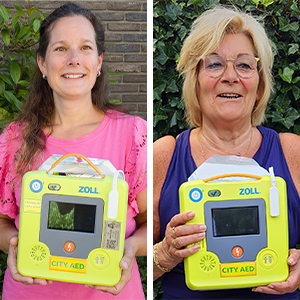In her spare time, Githa Hochstenbach volunteers in Vleuten, The Netherlands, for Hartslagnu, an organization that maintains a national network of volunteer civilian emergency responders. When someone reports a suspected sudden cardiac arrest (SCA), these volunteers bring an automated external defibrillator (AED) to the scene, often times before trained emergency responders arrive.
Although she lives directly across the street from a publicly accessible AED installed and maintained by a local ZOLL business partner called City AED,1 until recently Githa had no experience using one — beyond first aid training. “In the hospital, we do not work with an AED because we can check the heart rhythm ourselves and judge whether a shock is needed,” explains Githa.
That all changed quickly one evening when she received an urgent call from Hartslagnu asking her to retrieve the AED located near her home and deliver it to where fellow Vleuten resident Tonny Bos van Ewijk had collapsed while cycling. Bystanders who witnessed Tonny’s collapse suspected sudden cardiac arrest and called emergency services, who in turn notified Hartslagnu.
“The AED then began to give audio instructions and display visual instructions on its screen so I could clearly see what I needed to do; the AED guided us through the process.”
— Githa Hochstenbach,
volunteer civilian responder and SCA rescuer
Real-time guidance reassures civilian rescuers
“At the scene, people had already started CPR, but I was the first one there with an AED,” Githa recalls.
She quickly powered on the ZOLL AED 3® defibrillator and used the supplied scissors to cut away Tonny’s clothing. “The AED then began to provide audio and visual instructions so I could clearly see what I needed to do; the AED guided us through the process,” Githa explains.
After she applied the electrodes, the AED analyzed Tonny’s heart rhythm and recommended a shock. Once the shock was delivered, Githa followed the AED guidance to continue delivering cardiopulmonary resuscitation (CPR).
Thanks to Hartslagnu’s network of volunteer civilian responders and local business partners who place and maintain AEDs, when someone suffers sudden cardiac arrest, resuscitation can begin within 6 minutes.2
Emergency medical services, along with fire and police first responders, arrived soon after. EMS took over CPR and transported Tonny to the hospital, where she awoke in the intensive care unit (ICU), wondering why she was there. She has no memory of the event or even of that day. Following a brief stay in the hospital, Tonny was released. She has recovered and is now back to enjoying cycling, swimming, and other activities with her husband Gerard, her children, and grandchildren.
Ready for another rescue
Following the rescue, Githa returned the ZOLL AED 3 defibrillator to its home across from her house and notified City AED of its use. “In an unprecedented short period of time, they serviced the AED so that it was ready for another rescue,” says Githa.
On average, civilian emergency workers in The Netherlands get to a scene 2.5 minutes faster than an ambulance.2 Thanks to Hartslagnu’s network of volunteers and civilian responders, when someone suffers sudden cardiac arrest, resuscitation can begin within 6 minutes.2

Left to right: Rescuer Githa Hochstenbach and survivor Tonny Bos van Ewijk.
Tonny is grateful not only for the bystanders and first responders who came to her aid that day, but for the publicly accessible AED maintained by City AED. “In addition to CPR, the AED saved my life,” Tonny explains.
1 www.city-aed.nl
2 Hartslagnu website, https://hartslagnu.nl/nieuws/cijfers-2022/. Accessed Sep 2023.


